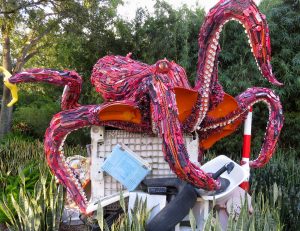Sea Sculptures: How Art Can Express Human Impact
Mason Rosecrans
Hello, my name is Mason Rosecrans, this portfolio is titled Sea Sculptures: How Art Can Express Human Impact and is under a CC BY-NY-NC-SA license.
The purpose of Sea sculptures or more specifically art sculptures built to represent the marine ecosystem is an attempt for artists to display the marine ecosystem found in the ocean to people that would normally not be able to see or interact with. Sculptures have been created to represent sea creatures for hundreds of years and can have different meanings. The specific type of sculptures I am focusing on is the more modern Sculptures built to show the effects that humans have directly and indirectly on marine life. The portfolio will contain several pictures and examples of sculptures created with these effects in mind.

Themes present in these art sculptures include Human Impact and Conservation. The message and primary theme of the art installations is to bring awareness to the impact that we humans have on the marine ecosystem and its biodiversity. This theme can visually be seen in all three sculptures building materials, as all structures are made from discarded plastic collected from the ocean and beaches. This fact leads to the next theme of conservation, as the ultimate goal of showing and creating these sea sculptures is to lead to greater conservation methods for marine life and prevent the destruction of aquatic life. Humans are responsible for an exponential increase in environmental damage, and these works of art bring this damage to life in hopes that we will take responsibility for restoring this damage.

Two of these images are from the Smithsonian National Zoo in a collection of sculptures called the “Art to Save the Sea,” each representing a different marine species made entirely of plastic waste collected from the ocean. These sculptures are brought in by an organization called Washed Ashore, which cleans beaches and recycles waste into sculptures. This specific art installation was opened to the public at the Smithsonian National Zoo in Washington D.C. in 2016, which is a free-entry zoo allowing hundreds of thousands of people to visit and view these art sculptures. Washed Ashore’s goal with this project is to “illustrate the tragedy of plastic pollution in our oceans and waterways.” The other and last image below is a picture of an art sculpture of a whale from the San Francisco area made entirely of plastic collected from beaches along the California coast. The art installation was created by the Monterey Bay Aquarium and, like the other structures, is bringing awareness to the pollution we have made in our oceans. The amount of plastic and human trash in the sea is the direct cause of these sculptures.

Sea Sculptures and art installations like this are very important for our society. The images of these art pieces help us as an entire population understand the effects we can have as individuals and the impact we can have together. We as a people need to come together and stop the destruction of our planet, and the best w ay to demonstrate the destruction we have already caused is through sea sculptures. This art structure is significant for us land animals as we can not always visually see the effects we have, and these installations help put into perspective what we are doing to the marine ecosystem.
Media Attributions
- Octopus is licensed under a CC BY-NC-ND (Attribution NonCommercial NoDerivatives) license
- Seal is licensed under a CC BY-NC-ND (Attribution NonCommercial NoDerivatives) license
- Whale is licensed under a CC BY-SA (Attribution ShareAlike) license

